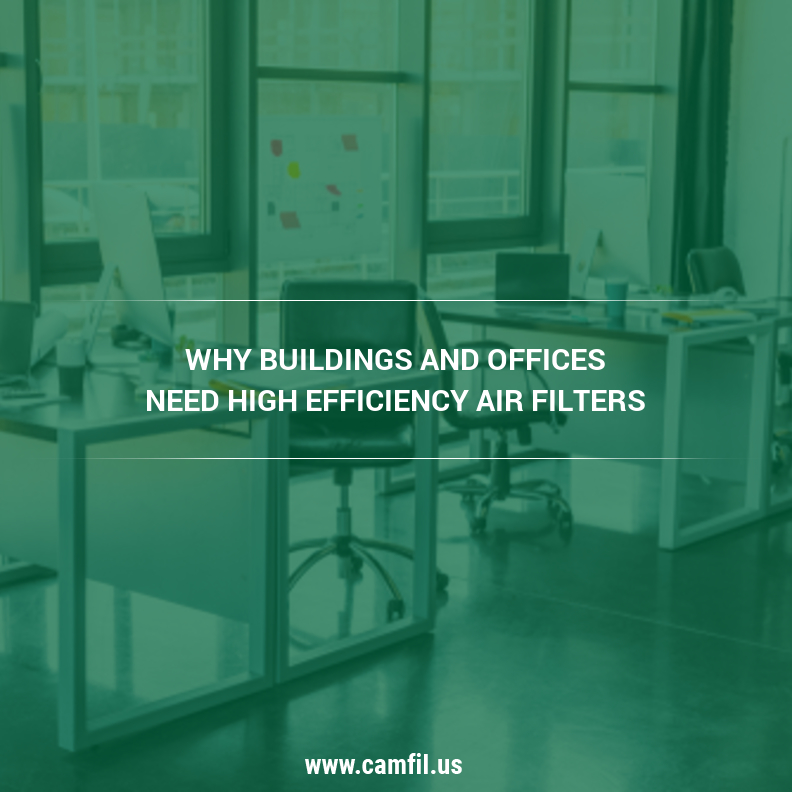Learn about the importance of high efficiency air filters in buildings and offices and how air purification systems protect indoor air quality.
Camfil Commercial Air Filters News – With the increased awareness about the dangers of outdoor and indoor air pollution, many businesses, building managers, and tenants are turning to high efficiency air filters to protect the air inside their establishments.
Given how most Americans spend as much as 90 percent of their time indoors and spend up to 60 hours a week inside office environments, it’s no surprise that indoor air quality is recognized as a pressing concern, having the potential of affecting the health, comfort, and productivity of building and office occupants.
What is Happening to Indoor Air Quality?
The problem is that indoor air quality can sometimes be worse than outdoor air quality, leading to health issues such as asthma and allergy attacks.
“Sick Building Syndrome is now a common label used for headaches, eye irritations, nasal irritations, fatigue and other symptoms that can be correlated to time spent inside a specific building or room,” said Camfil USA’s Charlie Seyffer, Manager of Marketing & Technical Materials for commercial air filters and 37-year ASHRAE member and active committee participant. “Building Related Illness refers to a specific diagnosable illness whose cause can be traced to a particular building or room. Legionnaire’s disease is an example of a Building Related Illness.”
The indoor air quality crisis can be traced back to the 1970s. It was during this time that energy usage became an important political and economic point of discussion due to widespread energy shortages, especially in developing countries. Naturally, the demand for energy, for electricity and heating led to an increase in the cost of heating, venting, and cooling of air in buildings.
Why Commercial Air Filtration Systems Are More Important Than Ever
The rise of commercial air filtration systems was also an effect of changes in construction techniques and choice of materials, with many buildings retrofitted with insulation, vapor barriers, and weather-sealed doors and windows. These construction techniques were vital in reducing the amount of heat transfer through walls, ceilings, floors, and windows, while also keeping outside air from entering the building through these areas.
Creating this sealed environment, however, also had the effect of encouraging the buildup of moisture and contaminants inside buildings, creating another air quality problem altogether.
Where Do Commercial High Efficiency Filters Come In?
Commercial high efficiency filters are designed to trap and remove the airborne pollutants that increase the risk of illness. For building owners and office managers, this means air filters reduce the likelihood of employees getting sick and using sick days, which in turn, protects their productivity numbers.
As early as 1989, the EPA has reported that improving indoor air quality can lead to better productivity and fewer employee absences. In fact, the agency estimates that indoor air quality issues cost the country tens of billions of dollars in productivity loss and medical care.
Multiple studies by the United States Environmental Protection Agency (EPA), state governments, and independent university research teams have consistently ranked indoor air pollution as a serious environmental health problem. While modern cleaning and safety standards have reduced severe indoor air quality problems, even well-maintained buildings can still experience spikes in diminished indoor air quality.
This, in turn, highlights the importance of having a commercial air filter to treat air inside offices and buildings.
Workplace Pollutants that Can Be Removed by Commercial High Efficiency Air Filters
Workplace managers and building owners need to take it upon themselves to create an indoor air quality program which involves the installation of commercial high efficiency air filters and regulations for the handling of pollution-causing materials. These pollutants include:
-
- Particulate matter – Particulate matter (PM) are particles of solid or liquid substances that are small and light enough to be carried by the airstream. The largest PM area visible under sun beams as dust-like particles. The human body does a fairly good job of protecting itself from these particles; it’s the smaller PM pollutants that are likely to be the cause of respiratory issues. These particles are not coming from just outside air; instead, they are also generated indoors by processes such as cooking, heating and lighting.
- Chemical pollutants – Chemical pollutant sources include cigarette smoke and emissions from solvents, paints, finishes, and materials that are common in buildings such as office equipment, wall and floor coverings, furniture, and cleaning products. These pollutants are also common in workplaces that handle chemicals and fuel.
- Biological contaminants – Biological contaminants are more common in hospitals and medical facilities, where bacteria, viruses, and fungi from sick patients put other recovering patients and healthcare workers at risk of becoming ill. These contaminants, however, will always be present in places where groups of people gather.
Things to Remember Before Installing an Air Purification System for Offices
When choosing an air purification system, it’s best to avoid cheap bargain filters. Before choosing an air filter system, be sure to consult a trusted provider of air filters.
To learn more about the importance of indoor air quality control in offices, talk to Camfil USA. You may also explore our catalog of air filtration systems to learn more about our products.
Media Contact:
Lynne Laake
Camfil USA Air Filters
T: 888.599.6620
E:Lynne.Laake@camfil.com
F: Friend Camfil USA on Facebook
Y: Watch Camfil Videos on YouTube
The post Why Buildings and Offices Need High Efficiency Air Filters appeared first on Air Filters for Clean Air.

